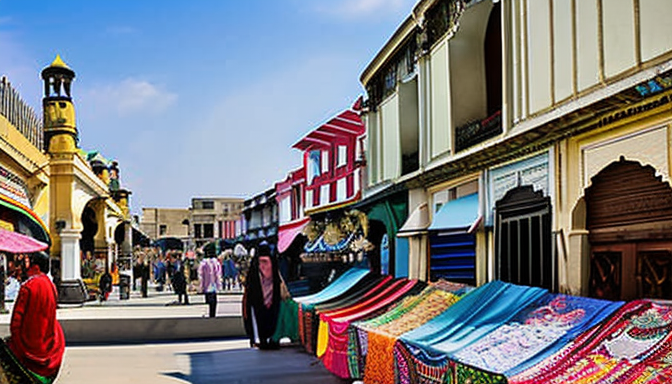Have you ever wandered through a city and felt its history whispering in your ear? Karachi is one such place. As you stroll through its streets, you can almost hear the echoes of the past. The **British Raj** left a significant mark on this vibrant city, shaping its identity in ways that are still visible today. From grand buildings to bustling markets, the remnants of colonial architecture tell stories of a different era.
Take a moment to appreciate the **stunning structures** that dot the landscape. Each one is a piece of a puzzle, revealing how Karachi transformed during the colonial period. Buildings like the **Frere Hall** and the **Sindh High Court** showcase a mix of **Gothic** and **Islamic** architectural styles. They stand tall, not just as landmarks, but as symbols of the cultural blend that defines Karachi.
But it’s not just about the buildings. The policies and governance during the British era shaped the very fabric of the city. Karachi became a **melting pot** of cultures, drawing people from various backgrounds. This diverse community contributed to a rich tapestry of traditions and practices that are still celebrated today. Imagine the bustling streets filled with the aromas of different cuisines, each telling its own story.
So, next time you walk through Karachi, remember: every corner holds a piece of history. The colonial past is not just a chapter in a book; it’s a living part of the city. Embrace it, explore it, and let it inspire you.
Colonial Landmarks and Architecture
Walking through Karachi is like flipping through a history book. Each corner reveals a story. The British Raj left its mark on this bustling city, shaping its skyline with stunning architecture. The buildings stand tall, whispering tales of a time when Karachi was a crucial port under colonial rule. Can you imagine the hustle and bustle? The streets were alive with merchants, soldiers, and families, all contributing to a vibrant tapestry.
Take a moment to admire the Frere Hall. This architectural gem, built in 1865, showcases a beautiful blend of Gothic and Italianate styles. It was originally designed as a town hall, and today, it serves as a reminder of Karachi’s colonial past. Just picture it—gatherings, celebrations, and discussions happening within its walls. What a lively scene!
Another landmark is the Mohatta Palace. This stunning structure was built in 1925 and is a perfect example of Rajput and Mughal architecture. It’s not just a palace; it’s a cultural hub, hosting art exhibitions and events. The intricate designs and vibrant colors draw you in, making you feel connected to a rich history.
These buildings are more than just bricks and mortar. They reflect the cultural influences that shaped Karachi. As you explore, you’ll notice how these structures tell the story of a city that has always been a melting pot of cultures. The colonial architecture is not just a backdrop; it’s a vital part of the city’s identity.

Cultural Influences and Heritage
Karachi’s colonial past is like a rich tapestry, woven with threads of diverse cultures and histories. The British Raj left an indelible mark on the city, shaping its identity in ways that are still visible today. Imagine walking down a street where every corner tells a story, where colonial architecture stands tall, whispering tales of a bygone era.
The British brought with them not just their governance but also their architectural styles. Buildings like the iconic Frere Hall and the majestic Mohatta Palace showcase a blend of Gothic, Indo-Saracenic, and Art Deco styles. These structures are more than just bricks and mortar; they are symbols of a time when Karachi was a bustling hub of trade and culture. Each façade reflects the aspirations and dreams of those who built them.
But it wasn’t just about the buildings. The policies during the colonial era encouraged a mix of cultures, creating a unique social fabric. Different communities—Muslim, Hindu, Parsi, and Christian—came together, sharing traditions, languages, and cuisines. This cultural melting pot is evident in the city’s festivals, food, and even its languages.
Today, as you stroll through Karachi, you can feel this vibrant heritage pulsating beneath your feet. The past is alive in every bustling market and quiet alley. The influence of colonial times is not just history; it’s a living part of Karachi’s identity.
Frequently Asked Questions
- What are some must-see landmarks in Colonial Karachi?
When visiting Colonial Karachi, don’t miss the stunning Frere Hall, the majestic Karachi Port Trust Building, and the iconic Mohatta Palace. Each of these landmarks tells a story of the city’s rich past and showcases beautiful architecture that will leave you in awe!
- How has colonial architecture influenced modern Karachi?
Colonial architecture has left an indelible mark on Karachi’s skyline. Many modern buildings incorporate elements from this era, blending historical charm with contemporary design. It’s like a dance between the past and the present, creating a unique identity for the city!
- What cultural influences shaped Colonial Karachi?
Colonial Karachi was a melting pot of cultures, with influences from the British, Persians, and local communities. This rich tapestry has contributed to the city’s vibrant traditions, festivals, and culinary delights, making it a fascinating place to explore!
- Is it easy to explore Colonial Karachi on foot?
Absolutely! Walking through the streets of Colonial Karachi is like stepping back in time. Many landmarks are within walking distance, allowing you to soak in the history and charm at your own pace. Just remember to wear comfy shoes!